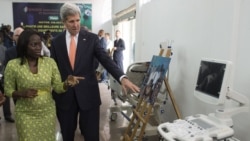Given that half of sub-Saharan Africa’s population is under the age of 18, it is not surprising that the continent’s population is expected to exceed four billion by the year 2100. “There is extraordinary potential for this generation of youth to shape the future of the continent in powerful ways,” said USAID Assistant Administrator Nancy Lindborg.
But too many of these children, some 200 million of them, live in extreme poverty. Many of them face long-term stress due to armed conflict, natural disasters or abuse. Such adversity diminishes their potential and dims Africa’s bright future.
“Children living under conditions of serious physical deprivation or danger or who experience violence, abuse and neglect face fundamental threats to their survival, well-being, and future. If we do not focus on the child, we lose the person,” said Assistant Administrator Lindborg. “Investments in a strong start for Africa’s children are critical to laying a foundation for a healthy, productive future for Africa itself.”
That is why the United States runs a number of programs to aid children living under stressful conditions. Through the Action Plan on Children in Adversity, launched in 2012 and implemented by USAID, the United States is helping vulnerable children in Africa and around the world by focusing on three main objectives.
First, we help build strong beginnings by reducing preventable and under-five child deaths. We do this by improving the health care and nutrition for both mother and child, starting at the beginning of pregnancy.
Second, we work to preserve the family unit by assisting families in need so they can provide basic care for their children; work to prevent family-child separation; and help separated families reunite.
And third, we work with national governments and partners to protect children from violence, exploitation, abuse, and neglect, including trafficking and child labor.
“USAID remains committed to meeting the needs of vulnerable children in Africa while also addressing the root issues that create the conditions for conflict and abuse,” said Assistant Administrator Lindborg. “Through our work in maternal and child health, nutrition, basic education, human rights, democratic governance, and humanitarian assistance we will continue tackle the underlying issues that lead to children’s vulnerability.”

















